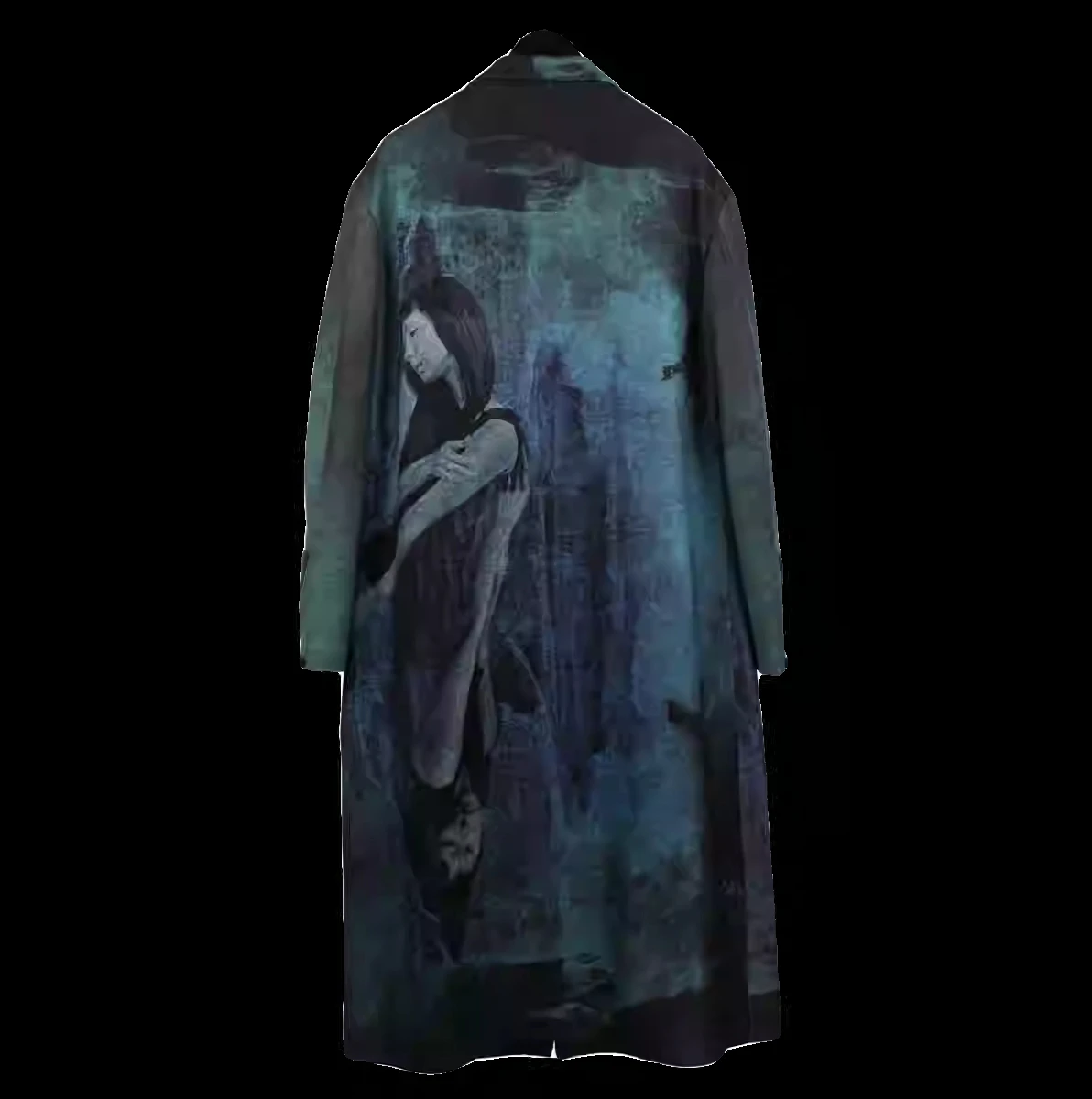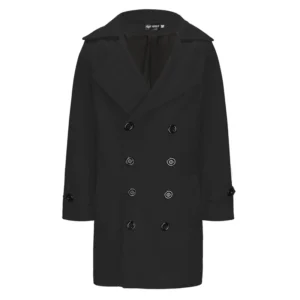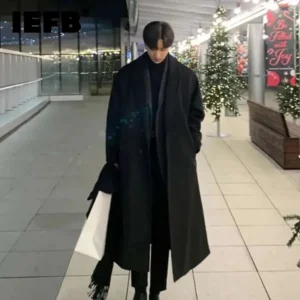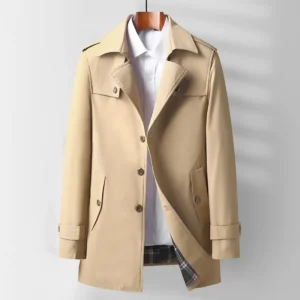Understanding Premium Cashmere: The Foundation of Luxury Overcoats
True cashmere is one of nature’s most exceptional materials, prized for centuries by those who appreciate genuine luxury. This remarkably soft and insulating fiber comes exclusively from the undercoat of cashmere goats, primarily raised in the high-altitude regions of Mongolia, China, and Iran. Unlike ordinary wool, cashmere is not obtained through shearing but through a careful combing process that collects only the fine, soft undercoat that these animals naturally develop to survive harsh mountain winters.
What makes cashmere truly special is its rarity. A single cashmere goat produces only about 5-6 ounces (150-170 grams) of usable fiber per year. To put this in perspective, it takes the annual yield from three to four goats to create just one high-quality overcoat. This limited production is a key factor in cashmere’s exclusivity and premium status in the world of fine textiles.
The extraordinary properties of cashmere begin at the microscopic level. Cashmere fibers measure between 14-19 microns in diameter, significantly finer than human hair (40-50 microns). This remarkable fineness creates the unmistakably soft hand-feel that cashmere is famous for, while simultaneously providing exceptional warmth. In fact, cashmere provides up to three times more insulation than regular wool despite being much lighter in weight.
When crafted into an overcoat, these natural properties translate into a garment that offers:
- Unparalleled softness against the skin
- Exceptional warmth without bulk or weight
- Natural breathability that regulates body temperature
- A distinctive drape and elegance that improves with time
- Remarkable durability when properly cared for
The premium cashmere overcoats available today represent the pinnacle of natural luxury in menswear. Understanding what makes this material so special helps explain why these garments command premium prices and why they’ve been coveted by discerning individuals throughout history. The question of whether 100% cashmere coats provide superior warmth is answered by the fiber’s natural structure, which creates millions of tiny air pockets that trap body heat with remarkable efficiency.
Deciphering Cashmere Quality: Expert Evaluation Criteria
Not all cashmere is created equal. The quality can vary dramatically based on several key factors that every potential buyer should understand. Cashmere is typically classified into grades (A, B, and C) that help indicate its quality, but these designations alone don’t tell the complete story.
The first critical quality factor is fiber length. Longer fibers create stronger yarns that resist pilling and maintain their appearance over time. Premium Grade A cashmere features fibers measuring 34-36mm or longer, while lower grades use progressively shorter fibers. This seemingly small difference has a significant impact on how the finished garment performs and ages.
Equally important is the fiber diameter, measured in microns. The finest cashmere (Grade A) measures between 14-15.5 microns, creating that incomparably soft feel against the skin. As the micron count increases in Grades B (16-19 microns) and C (19+ microns), the hand-feel becomes progressively less refined.
When evaluating cashmere quality in person, run your hand across the fabric. Truly fine cashmere should feel incredibly soft but not slippery or “soapy” – a telltale sign of chemical treatments used to mask lower quality. The garment should also have a subtle luster rather than a shiny appearance, which often indicates excessive processing or synthetic blending.
Weave density is another crucial factor. Hold the fabric up to light – a quality cashmere overcoat will have a tight, even weave with minimal light penetration. This density contributes to both warmth and durability, ensuring the garment maintains its structure for years.
For overcoats specifically, pay attention to ply – the number of yarn strands twisted together to create the thread. While single-ply can be appropriate for lightweight items, quality overcoats typically feature 2-ply or 3-ply construction, offering superior durability and insulation. The differences between cashmere blends versus pure cashmere become particularly important when evaluating overcoats, as blends may compromise the material’s natural properties.
| Grade | Fiber Length | Micron Count | Typical Feel | Expected Durability |
|---|---|---|---|---|
| A | 34-36mm+ | 14-15.5 | Exceptionally soft, lightweight | Excellent with proper care |
| B | 28-33mm | 16-19 | Very soft, slightly heavier | Good to very good |
| C | Under 28mm | 19+ | Soft but less refined | Fair to good |
To verify authentic cashmere, consider conducting a simple burn test on an inconspicuous fiber (if possible). Genuine cashmere will burn slowly, produce minimal ash, smell like burning hair, and leave a crushable bead. Synthetic fibers, by contrast, will melt rather than burn and may produce a chemical odor.
Understanding these quality indicators empowers you to evaluate cashmere overcoats beyond just the price tag or brand name, ensuring you select a garment that will provide lasting luxury and value.
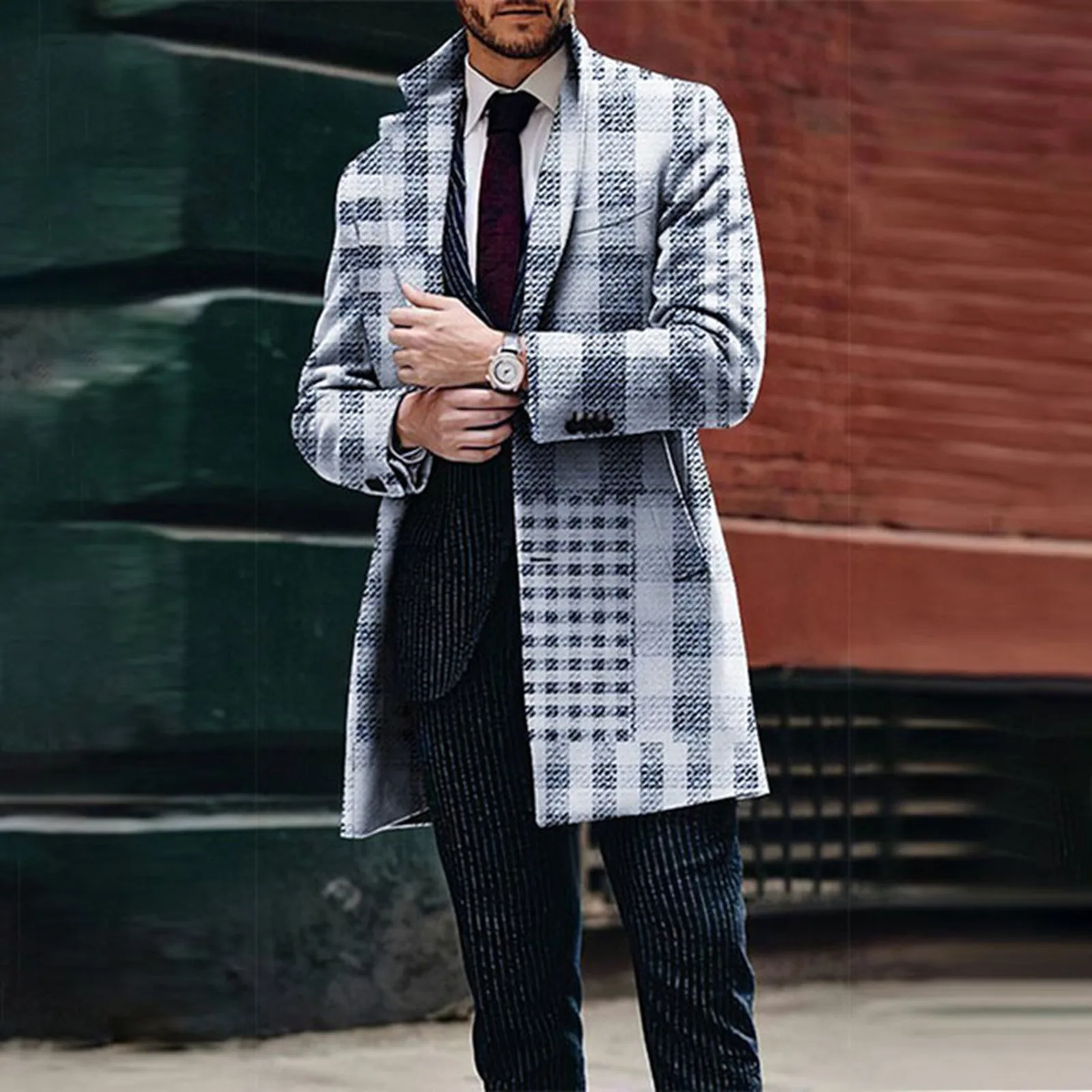
Overcoat Styles: Selecting the Silhouette That Flatters You
The style of your cashmere overcoat dramatically influences not only how it looks but how versatile it will be in your wardrobe. Several classic silhouettes have stood the test of time, each offering different advantages depending on your build and personal style.
Single-breasted overcoats represent the most versatile option, featuring a clean line with a single row of buttons (typically three or four). This streamlined silhouette flatters most body types and transitions seamlessly between formal and casual settings. The simplicity of this design makes it particularly suitable for men who prefer an understated aesthetic.
The double-breasted overcoat, with its overlapping front panels and two parallel rows of buttons, creates a more dramatic, powerful silhouette. This style adds perceived bulk to the chest and shoulders, making it especially flattering for leaner builds. For a truly distinguished appearance, double-breasted overcoat options provide timeless elegance with a touch of old-world sophistication.
The Chesterfield represents perhaps the most classic overcoat design, featuring a single-breasted closure, a velvet collar (though cashmere versions often use self-fabric), and a straight cut. This style typically falls to just above the knee and works exceptionally well with business attire.
The Polo coat, originally derived from the garments worn by polo players between matches, features a double-breasted front, a half-belt at the back, and patch pockets. Its slightly more casual heritage makes it versatile for both business and weekend wear.
Lapel style significantly impacts an overcoat’s character. Notch lapels offer versatility and a more casual feel, while peak lapels create a more formal, dramatic look that draws the eye upward and outward, enhancing shoulder width. The less common Ulster collar provides additional neck protection in harsh weather.
Coat length should complement your height and build. As a general guideline:
– For men under 5‘8” (173 cm): Choose above-knee lengths to maintain proportion
– For men 5‘8”-6‘2” (173-188 cm): Mid-thigh to knee length provides classic proportion
– For men over 6‘2” (188 cm): Longer styles to just below the knee can be accommodated
Body type also influences which style will be most flattering. Athletic builds can wear most styles successfully, while broader men may find single-breasted styles more flattering. Taller, thinner men often benefit from double-breasted styles that add perceived bulk. Choosing the right coat length dramatically affects the overall proportion and elegance of the garment.
For a complete understanding of available options, exploring the variety of cashmere overcoat styles helps ensure you select a silhouette that complements your physique and personal style while maintaining timeless appeal.
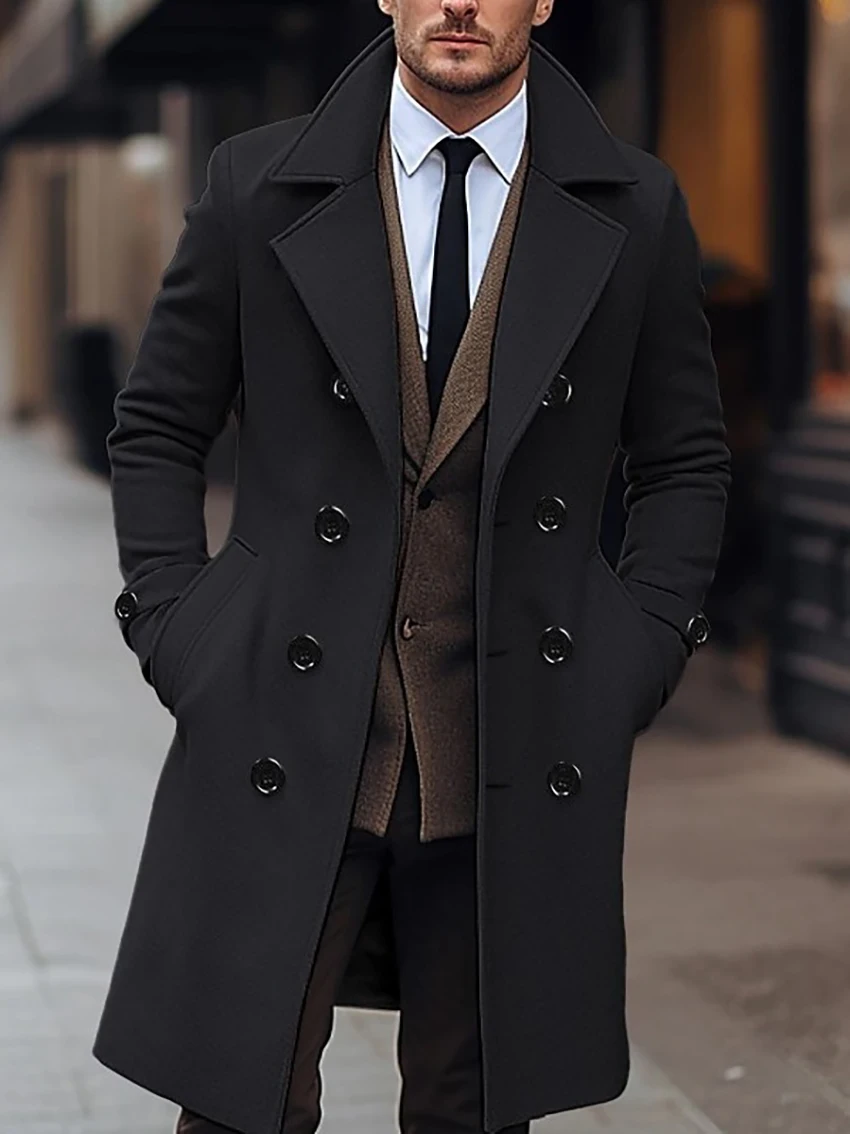
The Art of Fit: Ensuring Your Cashmere Overcoat Enhances Your Silhouette
The perfect cashmere overcoat begins with impeccable fit. Even the finest cashmere in the world will disappoint if the garment doesn’t properly complement your body. Unlike more casual outerwear, an overcoat should follow the lines of your body while allowing enough room for layering beneath.
The shoulders form the foundation of proper overcoat fit. The seam where the sleeve meets the body should align precisely with your natural shoulder edge. Too narrow, and the coat will pull and restrict movement; too wide, and you’ll look like you’re wearing someone else’s garment. This crucial fit point cannot be easily altered, making it perhaps the most important consideration when evaluating fit.
Proper chest fit allows you to comfortably button the coat while wearing a suit or jacket underneath. You should be able to slide a flat hand inside the buttoned coat at chest level—any more room suggests it’s too large, while any less indicates it’s too tight. Remember that mastering cashmere overcoat fit requires understanding that the coat should skim your body rather than hug it tightly.
Sleeve length should allow approximately half an inch (1.3 cm) of suit jacket sleeve to show when your arms are at your sides. The overall coat length should provide appropriate coverage based on the style (as discussed in the previous section) while maintaining balanced proportions.
To ensure practical comfort, perform these simple movement tests:
– Button the coat completely and cross your arms
– Reach forward as if shaking someone’s hand
– Raise your arms to approximately 90 degrees
– Sit down while the coat is buttoned
If any of these movements feels significantly restricted or causes the coat to pull excessively across the back or shoulders, the fit needs adjustment.
For the most flattering fit, use this comprehensive checklist:
– Shoulder seams align precisely with your natural shoulder edge
– Coat closes comfortably with a suit jacket underneath
– Sleeve length extends to cover suit sleeve with approximately ½ inch (1.3 cm) showing
– Back lies smooth without horizontal pulling when arms move forward
– Collar sits flat against the back of the neck without gapping
– Lapels lie flat against the chest when buttoned
– Length complements your height and the coat style
Remember that minor alterations can often perfect the fit of an overcoat. While shoulders are difficult to alter, sleeve length, waist suppression, and even overall length can typically be adjusted by a skilled tailor. Investing in these refinements ensures your cashmere overcoat provides both the comfort and elegance expected from such a luxurious garment.
Craftsmanship Indicators: Hallmarks of a Superior Cashmere Overcoat
Beyond the quality of the cashmere itself, the craftsmanship that transforms this precious material into an overcoat significantly impacts its appearance, comfort, and longevity. Discerning buyers should pay particular attention to several key construction elements that separate truly exceptional garments from the merely adequate.
Hand-finished details represent one of the clearest indicators of superior craftsmanship. Examine the buttonholes closely—premium cashmere overcoats feature hand-sewn buttonholes with small, even stitches that create a slight raised edge. This not only looks more refined but also provides superior durability compared to machine-made alternatives. Similarly, pick stitching (tiny, visible stitches near the edges of lapels and pockets) indicates meticulous handwork, with quality examples featuring 7-10 stitches per inch (2.5 cm).
The internal construction reveals much about an overcoat’s quality. Premium garments feature full canvas construction—a layer of horsehair canvas between the cashmere and lining that creates structure while allowing the coat to mold to your body over time. Less expensive options use fused construction (glued interfacing) that may bubble or delaminate with cleaning or exposure to moisture.
Lining quality dramatically affects both comfort and longevity. Superior overcoats use high-grade Bemberg cupro or silk linings that breathe, resist static, and move freely with the body. These materials represent a significant production cost but vastly improve the wearing experience. Check that the lining is attached with a floating construction that allows independent movement between the shell and lining, preventing strain on the delicate cashmere.
Seam construction provides clear evidence of quality. Premium overcoats feature fully taped seams (covered with fabric tape on the inside) to strengthen these stress points and prevent stretching. Pattern matching at seams—where herringbone, check, or other patterns align perfectly across seams—requires significant additional fabric and cutting precision, indicating meticulous attention to detail.
Button quality is often overlooked but reveals much about overall craftsmanship. Fine overcoats feature horn or high-quality corozo nut buttons that are secured with a reinforced shank and durable thread. Each button should be individually backed or “stays” on the inside of the facing for reinforcement, preventing future tearing.
Pocket construction deserves careful examination. Superior overcoats feature pockets with reinforced corners (bar tacks) to prevent tearing, along with clean, symmetrical construction. Internal pockets should be positioned thoughtfully and constructed with the same attention to detail as exterior elements.
The comprehensive range of men’s overcoats available today showcases varying levels of these craftsmanship details, with the finest examples representing generations of tailoring expertise combined with exceptional materials.
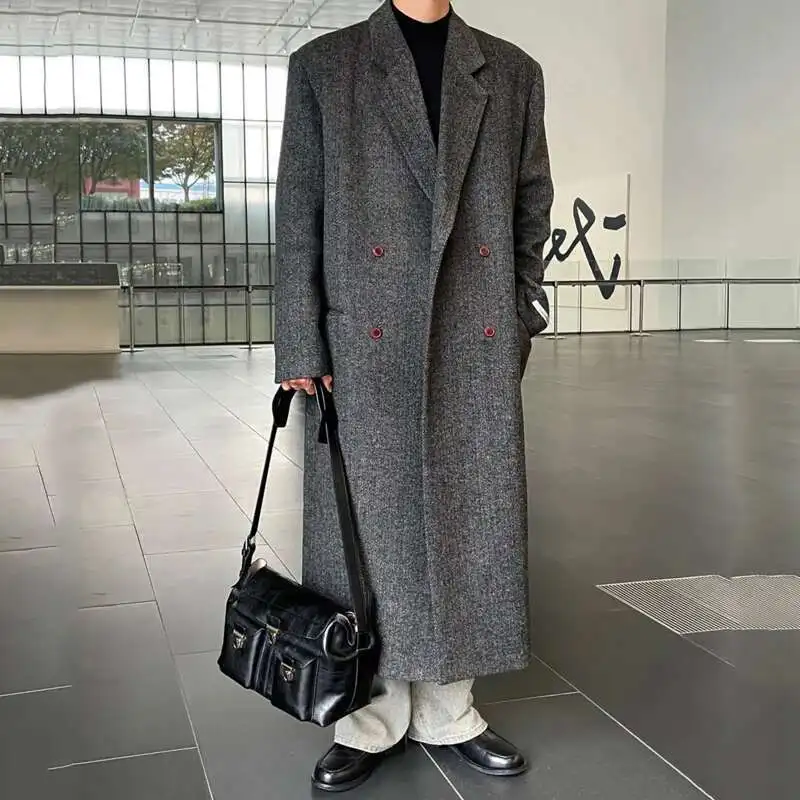
Comparing Luxury Fibers: Cashmere vs. Other Premium Materials
While cashmere holds an esteemed position in the hierarchy of luxury fibers, understanding how it compares to other premium materials helps inform a truly discerning purchase decision. Each natural fiber brings unique characteristics to an overcoat, with distinct advantages and considerations.
Traditional wool remains the most common overcoat material, offering excellent durability and warmth. Premium worsted wool can approach cashmere’s refinement but typically lacks its exceptional softness. Merino wool comes closer to cashmere’s hand-feel but doesn’t match its warmth-to-weight ratio. For those considering both options, traditional wool overcoats provide greater durability and often come at more accessible price points compared to pure cashmere.
Alpaca fiber, from the South American camelid of the same name, offers remarkable warmth and a distinctive silky feel. While less soft than cashmere, alpaca provides superior water resistance and durability. Its longer fibers create garments with excellent longevity, though they lack cashmere’s unparalleled softness against the skin.
Camel hair, another noble fiber, offers exceptional insulation with a distinctive golden hue. Less soft than cashmere but with superior moisture-wicking properties, camel hair creates overcoats with a unique character and excellent performance in variable temperatures. Its natural color limits dye options, making it less versatile from a style perspective.
At the pinnacle of luxury fibers stands vicuña, often called “the fiber of the gods.” Harvested from a small Andean camelid, vicuña is even rarer than cashmere with unmatched softness and extraordinary warmth. However, its extreme scarcity makes vicuña garments prohibitively expensive for most, often costing five to ten times more than even the finest cashmere.
| Fiber Type | Warmth-to-Weight | Durability | Softness | Water Resistance | Wind Resistance | Maintenance | Relative Cost |
|---|---|---|---|---|---|---|---|
| Cashmere | 5/5 | 3/5 | 5/5 | 2/5 | 4/5 | 3/5 | 4/5 |
| Wool | 3/5 | 5/5 | 2/5 | 3/5 | 3/5 | 4/5 | 2/5 |
| Alpaca | 4/5 | 4/5 | 3/5 | 4/5 | 3/5 | 4/5 | 3/5 |
| Camel Hair | 4/5 | 4/5 | 3/5 | 3/5 | 4/5 | 3/5 | 3/5 |
| Vicuña | 5/5 | 3/5 | 5/5 | 2/5 | 5/5 | 2/5 | 5/5 |
Cashmere blends represent a middle path, combining cashmere with wool or synthetic fibers to enhance durability while maintaining some of cashmere’s desirable properties. These blends typically offer greater resilience and easier care at a more accessible price point. However, the dilution of cashmere content (sometimes as low as 5-10%) can significantly reduce the luxurious hand-feel and insulating properties that make pure cashmere so desirable.
For those exploring various options, quality wool coats provide an excellent reference point against which to compare cashmere’s unique properties. The ideal choice ultimately depends on your specific needs, climate, and how you balance the priorities of softness, durability, and investment value.
Investment Value: Understanding Price Determinants and Long-Term Worth
Purchasing a cashmere overcoat represents a significant investment that, when made wisely, provides exceptional value over many years. Understanding what drives pricing helps ensure you invest appropriately for your needs while avoiding both overpriced mediocrity and false economies.
The grade and origin of the cashmere itself constitutes the most significant price factor. Garments made from Grade A cashmere from Mongolia or Inner Mongolia typically command premium prices due to the exceptional quality of the raw material. The quantity of cashmere also impacts cost—a heavier weight overcoat requires significantly more of this precious fiber than a lighter garment.
Construction methods dramatically influence price points. Fully canvassed overcoats with extensive handwork require many more hours of skilled labor than fused garments assembled primarily by machine. This labor intensity, particularly when performed by experienced craftspeople in regions with higher wages, substantially increases production costs.
At the entry-level tier ($800-1,500), expect good quality cashmere that may be a blend or Grade B/C material, with primarily machine construction and basic detailing. These garments offer the essential luxuries of cashmere but may lack the refinement and longevity of higher-grade options.
The mid-range tier ($1,500-3,000) typically features pure Grade A or B cashmere with superior construction. These garments often incorporate some handwork in critical areas like buttonholes and may feature half-canvas construction. For many buyers, this tier represents the optimal balance of quality and value.
The luxury tier ($3,000+) offers the finest Grade A cashmere with full canvas construction and extensive handwork throughout. These garments often come from heritage brands or specialized ateliers with generations of expertise. At this level, expect exceptional attention to detail, superior materials throughout (including linings and buttons), and the potential for customization.
Determining whether a cashmere overcoat is worth the investment requires considering cost-per-wear, a calculation that often reveals surprising value. A $2,000 overcoat worn 30 times per year over 10 years results in a cost of approximately $6.67 per wear—less than many casual dining meals and considerably less than similarly priced fashion items worn only a few times.
Beyond pure economics, a timeless cashmere overcoat investment provides intangible benefits including the daily pleasure of wearing an exceptional garment, the confidence that comes from being well-dressed, and the satisfaction of owning an item that may eventually become an heirloom. When properly selected and cared for, few wardrobe investments offer comparable long-term returns in both utility and enjoyment.
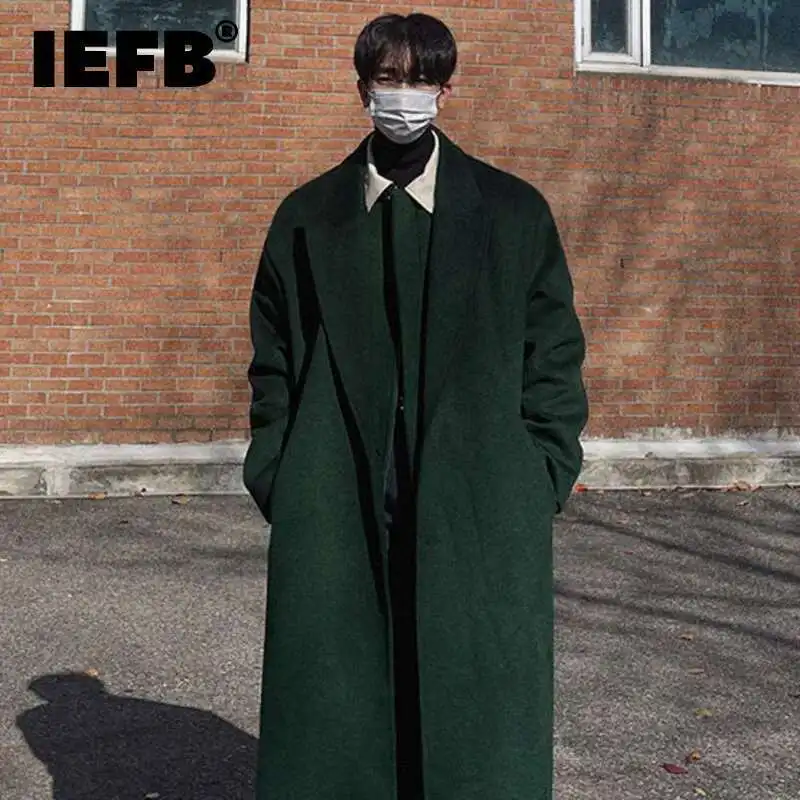
Care and Maintenance: Preserving Your Cashmere Investment
Proper care dramatically extends the life of a cashmere overcoat, transforming it from merely a purchase into a long-term investment. Following specific maintenance protocols ensures your garment retains its luxurious appearance and performance for many years.
After wearing, always allow your cashmere overcoat to rest for at least 24 hours before wearing it again. This recovery period allows the natural fibers to return to their original shape and release moisture. During this time, hang the coat on a properly sized, broad wooden or padded hanger that supports the shoulders without stretching them. Avoid wire hangers, which can distort the garment’s shape over time.
Brush your overcoat regularly with a soft-bristled garment brush. Use gentle, downward strokes following the fabric’s grain to remove surface dust and debris before it becomes embedded in the fibers. This simple routine significantly reduces the need for cleaning while maintaining the fabric’s appearance.
For storage during warmer months, clean the coat thoroughly before putting it away. While professional dry cleaning is typically recommended for full cleaning, limit this to once per season as the chemicals can eventually damage cashmere fibers. Choose a dry cleaner experienced with luxury garments and specify that they use gentle solvents suitable for cashmere.
Proper storage is crucial for preventing moth damage. After cleaning, store your overcoat in a breathable garment bag (avoid plastic, which can trap moisture) with cedar blocks or lavender sachets as natural moth deterrents. Ensure the storage area is cool, dry, and dark to prevent fading or mildew development.
Address pilling—those small balls of fiber that can form on the surface—promptly but gently. Use a cashmere comb or a fine-toothed sweater stone rather than electronic defuzzers, which can damage the delicate fibers. Work in one direction with light pressure, focusing only on affected areas.
For small stains or spots, act quickly but cautiously. Blot (never rub) liquid spills immediately with an absorbent cloth. For minor stains, gently spot clean with cold water and a minimal amount of mild detergent specifically formulated for wool or cashmere. Test any cleaning solution on an inconspicuous area first.
Minor repairs should be addressed promptly before they worsen. Small holes or tears can often be rewoven by specialized services that can make the repair nearly invisible. Button reinforcement or replacement should be performed at the first sign of loosening to prevent loss.
These care practices represent a small investment of time that yields significant returns in maintaining your cashmere overcoat’s appearance and extending its useful life, ensuring you enjoy the full value of your investment for many years.
Mens Double Breasted Pea Coat, Mens Wool Blend Coat, Mens Wool Pea Coat
Price range: $136.84 through $157.36 Select options This product has multiple variants. The options may be chosen on the product pageMens Cashmere Overcoat, Mens Hooded Winter Coat, Mens Wool Blend Coat
Price range: $128.72 through $139.68 Select options This product has multiple variants. The options may be chosen on the product pageMens Black Overcoat, Mens Black Wool Coat, Mens Wool Overcoat
$339.18 Select options This product has multiple variants. The options may be chosen on the product pageMens Grey Overcoat, Mens Wool Blend Coat, Mens Wool Overcoat
$201.28 Select options This product has multiple variants. The options may be chosen on the product pageMens Herringbone Coat, Mens Long Overcoat, Mens Wool Overcoat
Price range: $197.16 through $203.69 Select options This product has multiple variants. The options may be chosen on the product pageMens Long Overcoat, Mens Topcoats
Price range: $189.40 through $196.88 Select options This product has multiple variants. The options may be chosen on the product page
The Purchase Process: Final Inspection Checklist
When the moment arrives to make your cashmere overcoat investment, a methodical final inspection ensures you receive genuine quality that will provide satisfaction for years to come. This comprehensive evaluation should occur whether purchasing in person or assessing a newly received online order.
Begin by examining the overall appearance in good lighting. The color should be rich and consistent throughout the entire garment without fading, streaking, or irregularities. For patterned fabrics like herringbone or check, verify that patterns align precisely at all seams—a hallmark of quality cutting and construction.
Inspect all stitching with careful attention. Quality overcoats feature even, straight seams with consistent stitch length and tension. There should be no loose threads, puckering, or irregularities, particularly at stress points like pocket corners and button attachments. Hand-finished details should show consistency in execution.
Evaluate symmetry throughout the garment. Lay the coat flat and verify that the sides match in length and width. Check that pockets are positioned at identical heights, lapels have matching widths and angles, and the back vent (if present) hangs straight without pulling to either side.
Buttons deserve particular scrutiny as they indicate overall quality standards. Each button should be securely attached with a proper shank that provides clearance for the thick cashmere fabric. The buttonholes should be neatly finished with no loose threads or irregular stitching. Button yourself into the coat and verify that the closure lies flat without puckering or pulling.
When purchasing in-store, ask specific questions that reveal the retailer’s knowledge and the garment’s provenance:
– What grade of cashmere is used in this overcoat?
– Where was the cashmere sourced from?
– What is the cashmere’s average fiber length and micron count?
– Is the coat fully canvassed, half-canvassed, or fused?
– What type of interlining and canvas materials are used?
– Are any elements finished by hand, and if so, which ones?
For online purchases, conduct this inspection immediately upon receipt while return options remain available. Quality retailers should be able to answer detailed questions about construction even through remote channels.
The best timing for purchasing a premium cashmere overcoat often comes at the end of the winter season when retailers may offer reduced pricing on remaining inventory. However, selection may be limited during these periods. For the optimal combination of selection and value, consider shopping in early to mid-fall when new collections are fully available but occasional early-season promotions may occur.
Choosing the perfect cashmere overcoat ultimately requires this careful final assessment to ensure the garment you select truly delivers the quality and value expected from such a significant investment.
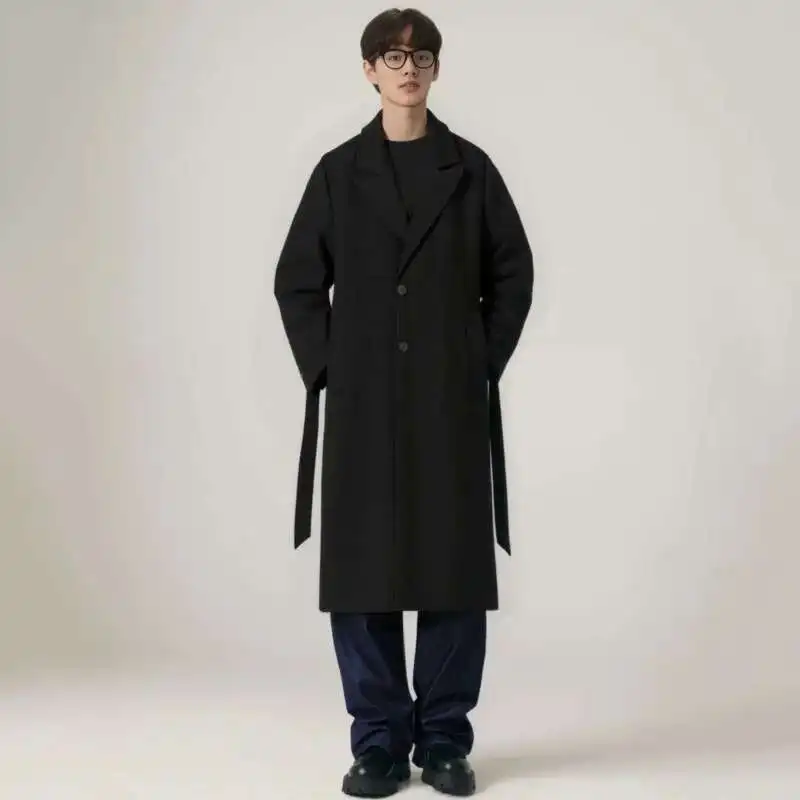
Style Versatility: Maximizing Your Cashmere Overcoat’s Potential
A well-chosen cashmere overcoat transcends being merely outerwear—it becomes a signature piece that enhances your entire wardrobe. Understanding how to style this investment across various contexts maximizes its versatility and value.
For formal business settings, pair your overcoat with tailored suits in complementary tones. Navy or charcoal overcoats offer tremendous versatility with most business attire. Ensure your coat length appropriately covers your suit jacket—ideally by 2-3 inches (5-7.5 cm). Complete the look with leather gloves, a cashmere scarf in a subtle pattern, and polished dress shoes for an executive presence that communicates attention to detail.
Business casual environments allow greater styling flexibility. Your cashmere overcoat elevates even simple combinations like flannel trousers with a merino sweater and open-collar shirt. This approach maintains professionalism while showcasing personal style. Consider slightly more expressive accessories like textured scarves or distinctive gloves that add character without overwhelming the refined elegance of the coat.
For weekend elegance, styling your men’s cashmere overcoat with premium dark denim, a lightweight cashmere sweater, and suede boots creates a sophisticated casual appearance appropriate for fine dining, cultural events, or social gatherings. This combination balances refinement with approachability—particularly effective with camel, medium grey, or navy overcoats.
Evening formal occasions call for your overcoat to complement formal wear. Dark colors like black, midnight blue, or charcoal work beautifully over tuxedos or formal suits. For black-tie events, consider styling with a white silk scarf and leather gloves for timeless elegance that recalls cinema’s golden age.
Color selection significantly impacts versatility. Neutral tones like navy, charcoal, camel, and black offer maximum flexibility across wardrobes and occasions. These classics complement virtually any underlying outfit while maintaining their relevance year after year. For those with extensive outerwear collections, more distinctive colors like burgundy, bottle green, or rich brown provide stylish alternatives while still offering considerable versatility.
Mastering the art of layering becomes essential for extending your overcoat’s wearable season. During transitional weather, lighter layers beneath allow comfortable wear during fall and spring. As temperatures drop, incorporate heavier knits, vests, or scarves for additional insulation without compromising the coat’s clean lines.
Accessorizing thoughtfully enhances your overcoat’s appearance while expressing personal style. Consider investing in:
– A selection of scarves in varying weights and patterns
– Quality leather gloves in colors that complement your coat
– A well-crafted umbrella that pairs aesthetically with your outerwear
– A classic hat like a fedora or flat cap for both style and protection
This versatility across contexts demonstrates why quality dress coats remain essential investments for the discerning gentleman. By thoughtfully styling your cashmere overcoat across these various scenarios, you transform it from merely a practical winter garment into a cornerstone of personal style that elevates your entire wardrobe.

